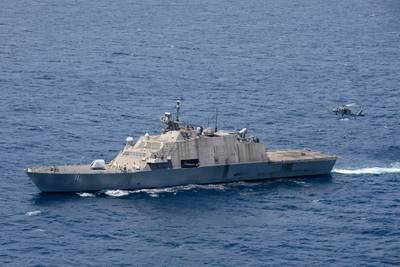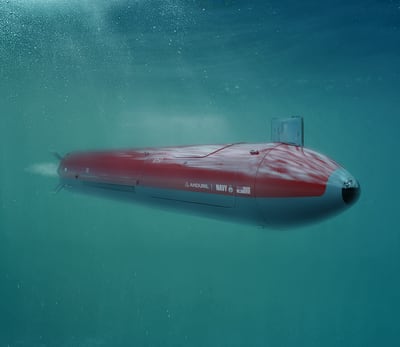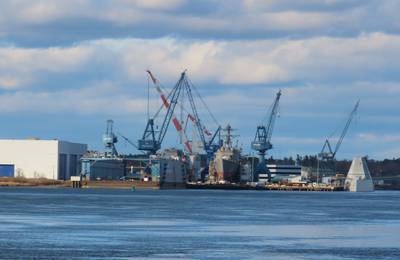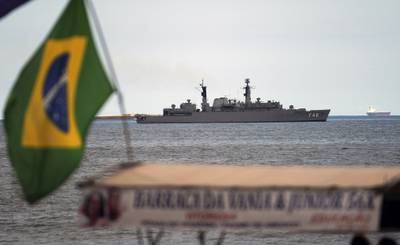
JERUSALEM — Israel has received its fourth and final Sa’ar 6 warship as the country implements a new naval doctrine aimed at bolstering defensive capabilities in its exclusive economic zone.
Israel has been receiving the ships since November 2020. The arrival of the Nitzahon corvette on Aug. 30 in the port of Haifa follows its two-week journey from Germany, where it was built. It also came a day before Israel announced a naval exercise dubbed Noble Waters with the U.S. Navy’s 5th Fleet.
The Israel Defense Forces characterize the Sa’ar 6 corvettes as central to its naval “defensive wall” as well as a key pillar in the maritime protection of both Israeli waters and energy assets at sea.
The commanding officer of the Israeli Navy, Vice Amd. Eli Sharvit, welcomed the Nitzahon to Haifa. He called the ships a tremendous addition for Israeli naval superiority and a key pillar in the strategic capabilities of the Navy, the IDF and the country.
“The line attached to the dock
IDF Chief of Staff Lt. Gen. Aviv Kochavi also attended the ceremony.
An event was held in July for the arrival of the third ship, the Atzmaut. It was transferred to the Israeli Navy at the German shipyard of ThyssenKrupp Marine Systems.
“We are at the heart of a dynamic environment, changing at a rapid pace and in every possible dimension. Our operational world requires endless capabilities. It requires us to reinvent ourselves and to direct each operational unit according to its individual abilities. To create methods of action that bring the whole to be greater, much greater, than the sum of its parts,” Sharvit said at the time
The other corvettes, the Magen and Oz, are in the process of being outfitted with Israeli systems and capabilities, including combat systems, before they can be fielded.
Many of the defense systems on the ships are new, and about 90 percent were designed by Israeli defense companies Rafael Advanced Defense Systems, Elbit Systems and Israel Aerospace Systems. These include multimission MF-STAR Adir radar from IAI, the naval version of the Iron Dome defense system from Rafael and an electronic warfare suite from Elbit Systems. The ships are also to be equipped with systems to counter missile threats, Barak missile interceptors and 76mm cannons.
The ships are 90 meters long and weigh 2,000 tons, They have a range of about 2,500 nautical miles, giving them the capability to remain at sea for extended periods of time. The IDF noted that 70 percent of Israel’s electricity comes from natural gas produced by Israel’s marine gas rigs, which means these areas must be protected.
Israel signed an EastMed pipeline deal with Cyprus and Greece in 2020, and held joint naval exercises, dubbed Noble Dina, with Cyprus and France this year.
Israeli’s decision to modernize its naval fleet over the last decade comes as it works to upgrade its ground forces, acquire new drones and strengthen its F-35 fighter fleet, as well as purchase new refueling aircraft and helicopters.
Seth Frantzman is the Israel correspondent for Defense News. He has been covering conflict in the Middle East since 2010. He has experience covering the international coalition against the Islamic State group in Iraq and Syria, and he is a co-founder and executive director of the Middle East Center for Reporting and Analysis.

First Navy submarine uses Portsmouth’s improved dry dockThe super flood basin is akin to a navigational lock that upgrades the shallowest of the shipyard’s dry docks, allowing submarines to enter independent of tides and without buoyancy.

First LCS deploys to European waters in 6th FleetThe Florida-based Freedom-variant LCSs have only operated in local waters and in Central and South America until now, two years after an LCS was originally planned to deploy to 6th Fleet for the first time.

Anduril Industries in talks with Australia on autonomous undersea vehicleThe company billed the Extra Large Autonomous Undersea Vehicle as affordable, durable and capable of executing military and non-military missions.

General Dynamics names new Bath Iron Works presidentA 10-year General Dynamics executive was named president of the company's Maine shipyard, after the former president resigned abruptly last month.

Delay hits Brazil’s $1.7 billion frigate programConstruction of the first of four Tamandaré-class frigates for the Brazilian Navy is delayed, with the shipbuilding timeline slipping from last month to this September, and commissioning potentially being pushed from 2025 to 2026.















